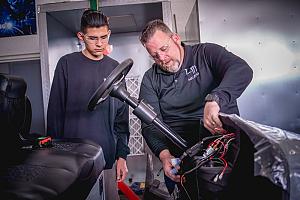Principal
- FMA
- The Fabricator
- FABTECH
- Canadian Metalworking
Categories
- Additive Manufacturing
- Aluminum Welding
- Arc Welding
- Assembly and Joining
- Automation and Robotics
- Bending and Forming
- Consumables
- Cutting and Weld Prep
- Electric Vehicles
- En Español
- Finishing
- Hydroforming
- Laser Cutting
- Laser Welding
- Machining
- Manufacturing Software
- Materials Handling
- Metals/Materials
- Oxyfuel Cutting
- Plasma Cutting
- Power Tools
- Punching and Other Holemaking
- Roll Forming
- Safety
- Sawing
- Shearing
- Shop Management
- Testing and Measuring
- Tube and Pipe Fabrication
- Tube and Pipe Production
- Waterjet Cutting
Industry Directory
Webcasts
Podcasts
FAB 40
Advertise
Subscribe
Account Login
Search
Repetition and the lean manufacturing road map
How repetition sustains improvement
- By Jeff Sipes
- March 5, 2019
- Article
- Shop Management
As the continuous improvement manager at your company, you have been on your lean journey for several amonths, maybe several years. You’ve educated, trained, and involved most of your workforce in various improvement projects. Now you’re starting to cycle back to people who were involved earlier to be engaged in an upcoming project.
Although they underwent training at different times, some two months ago and some 18 months ago or more, they all have had training. So for this most recent project, there’s no need for additional training, right? Let’s just jump right in and make the process better.
But should they really skip the training? What if they do not remember what was presented before? Surely they don’t need training again. After all, you’ve retained the knowledge … at least most of it. But you’ve also been immersed in lean projects for the past two years—and they have not. What should you do? The short answer is, Train them! When it comes to continuous improvement, repetition is a good thing.
Going in Fits and Starts
The lean journey brings about a lot of change. Physical processes change. Jobs change. Product flow and the shop layout might be unrecognizable. Perhaps most important, what you expect from your workforce changes too.
As your lean journey evolves, you’ll expect more from your leaders, managers, supervisors, technicians, and front-line workers. You expect them to understand their upstream suppliers and downstream customers. They should be problem-solvers, and they should contribute to the rhythm of your lean operations. It truly is a different game for everyone.
How you manage such radical change will make a world of difference in how effective your company is in its deployment of lean methods. Are you taking a smooth and methodical approach, or are you going in fits and starts?
Going in fits and starts can be risky. You often end up with “jerky” project flow, last-minute rushes, and a kind of “hurry-up-and-wait” execution. Employees see little evidence of improvement, then suddenly witness a burst of activity, after which things settle back down to business as usual. They see right through the lack of planning and constancy of purpose. In this case, improvement and skill-building are anything but repetitive.
Why Repetition Is Good
In many ways repetition sounds like pure non-value-added effort, a waste. But when you are attempting to institute the magnitude of change that comes with the lean journey, repetition works.
Say you gather a few employees for a lean project. They all went through lean training six months ago and had a brief orientation on lean manufacturing a year ago. You plunge ahead with the current project, assuming that they’ve had the training they need and are good to go. But to your surprise, they don’t seem to remember much at all! How could that be?
Blame the fits and starts. When you train in fits and starts—brief exposure, then nothing, a heavy dose in a kaizen event, then nothing for a long time—retention will be marginal at best. If employees are not living lean every day, they are bound to forget and focus on what is in front of them at any given moment. The shelf life of knowledge, if not utilized and put into action, is surprisingly short.
Repetition keeps the knowledge fresh. It also reinforces that gaining and using the newfound lean knowledge is important to the employee, to the performance of the company, and to your ability to fulfill customer needs.
You can apply repetition to training, using standard work, and to many other elements that make your company a lean enterprise. Considering all this, you can make a solid business case for repetition.
Examples and Benefits
Historically, manuacturing has been all about repetition, particularly for the company that makes the same product all day long, all month long, and maybe even all year long. That’s not reality for most companies today, of course. But many other forms of manufacturing work benefit significantly from repetition.
Repetition of training keeps employees engaged and informed. If you present an orientation to employees at the beginning of your lean journey, you can’t expect they will “get it” and remember everything months down the road.
Continuing training will enable employees to grow, be actively involved in improvement, and put effective ideas to work. If several employees are participating in their third kaizen event, do they need to go through the first half-day of training? The answer is yes. The training reinforces the knowledge and allows them to share some of what they have learned and done.
Effective communication is essential. Are you having monthly all-hands meetings? Is there a monthly or bimonthly newsletter that conveys important messages? Are your supervisors conducting daily stand-up meetings? Such repetitive communication gets everyone in a rhythm.
Employees come to expect such communication. It becomes habitual, and that is a good thing! The repetition helps you send targeted messages to all employees. No one is left out, and everyone is a contributor. Not least, such communication helps demonstrate respect for people.
And yes, even kaizens repeat. If you did a kaizen event in a particular area four months ago, why would you possibly do another kaizen in the same area? The simple answer is to achieve even further improvement. Once the previous improvements have been fully implemented and sustained, you take the opportunity to look for more improvement. This isn’t a knock on the previous improvement team’s work. Rather, it shows your willingness to dig deep for real improvements that make a difference. Repeating a formal kaizen event can help you create a critical mass of employees who can then begin to practice everyday kaizen—that is, the many small but critical improvements that employees can make themselves. This perpetuates the improvement process in the area.
How about standard work as a form of repetition? You expect your employees to consistently follow the established best practice—that is, the standard practice. Repeating standard work reduces variation and establishes a baseline for further improvement. It serves as both a training tool (helping people new to this job do it right the first time) and an auditing tool (to make sure standard work is being followed). If the employees do not understand the reason for standardization, they might think it is punitive and drudgery. If they understand, then disruptions should be minimal.
Numerous other examples illustrate the power of repetition, but you get the idea. Do not shy away from putting employees through another round of training, even if they have seen most of the material many times before. If you have developed a set of operating principles, share those principles at every meeting and figure out how everything you do supports them. Make it so repetitive that everyone in the company knows those principles inside and out. Conduct surveys or audits to measure levels of understanding. This is extreme repetition, but it makes a big difference. Ultimately, it focuses people’s time on what is important.
How many times should someone be trained? How many all-employee meetings should you hold? How many times should the leadership team conduct book studies? These questions and others will start to surface. But asking “How many?” is the wrong question. The real question is, “How often?” The answer depends on where your company is on its lean journey. But the journey itself and, hence, the repetition never end.Muscle Memory
Repetition develops the muscle memory that enables people to act in lean ways, as if it is the normal way of doing business. You do not have to think about what to do, nor do you need to reinvent the wheel every time a problem arises.
Using that muscle memory gained through repetition, everyone can make quick, decisive, effective decisions; continue the good work; and make a real difference.
Jeff Sipes is principal of Back2Basics LLC, 317-439-7960, www.back2basics-lean.com. If you have improvement ideas you’d like to read about, email him at jwsipes@back2basics-lean.com or Senior Editor Tim Heston at timh@thefabricator.com.
About the Author

Jeff Sipes
9250 Eagle Meadow Dr.
Indianapolis, IN 46234
(317) 439-7960
subscribe now

The Fabricator is North America's leading magazine for the metal forming and fabricating industry. The magazine delivers the news, technical articles, and case histories that enable fabricators to do their jobs more efficiently. The Fabricator has served the industry since 1970.
start your free subscription- Stay connected from anywhere

Easily access valuable industry resources now with full access to the digital edition of The Fabricator.

Easily access valuable industry resources now with full access to the digital edition of The Welder.

Easily access valuable industry resources now with full access to the digital edition of The Tube and Pipe Journal.
- Podcasting
- Podcast:
- The Fabricator Podcast
- Published:
- 05/14/2024
- Running Time:
- 62:12
Cameron Adams of Laser Precision, a contract metal fabricator in the Chicago area, joins the podcast to talk...
- Trending Articles
A visit to Automate 2024 reveals the future might be now

Why employee-owned companies make sense in manufacturing

What software automation means for custom fabrication

Majestic Steel Arkansas fully operational

Nucor’s weekly steel price announcement continues to rattle markets

- Industry Events
Laser Welding Certificate Course
- May 7 - August 6, 2024
- Farmington Hills, IL
World-Class Roll Forming Workshop
- June 5 - 6, 2024
- Louisville, KY
Advanced Laser Application Workshop
- June 25 - 27, 2024
- Novi, MI
Precision Press Brake Certificate Course
- July 31 - August 1, 2024
- Elgin,


























